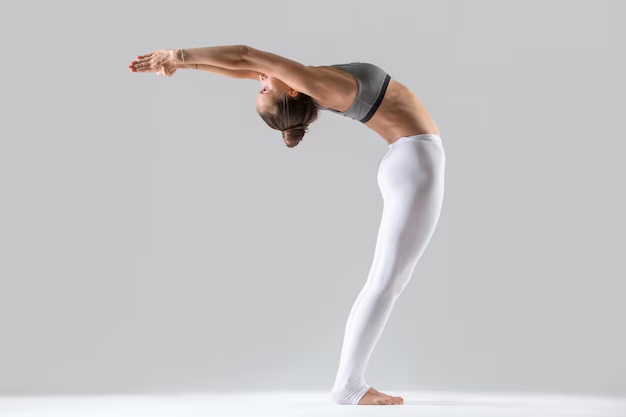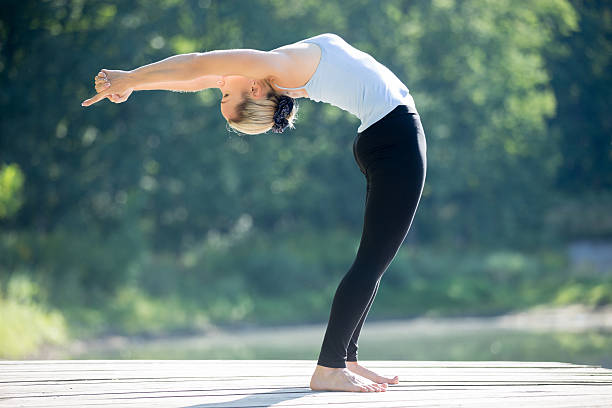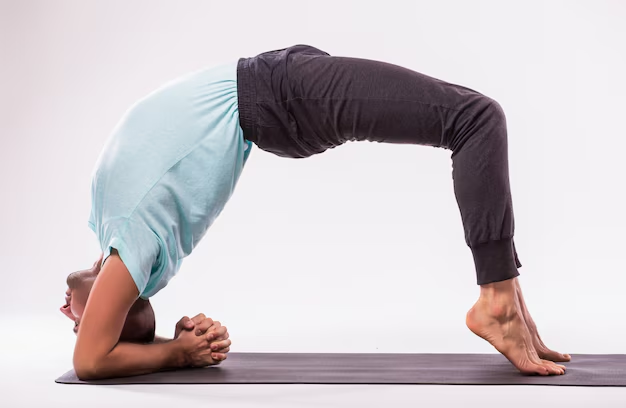Table of Contents
Introduction
Ardha Chakrasana, commonly known as the Half Wheel Pose, is a yoga asana that offers significant benefits to both the body and the mind.
This pose helps in unlocking strength, flexibility, and balance while opening up the chest and spine. In this article, we will explore everything you need to know about Ardha Chakrasana, from its origin and benefits to a detailed guide on how to perform the pose and some tips for maximizing its effects.
Whether you’re a beginner or an advanced yogi, Ardha Chakrasana has something to offer to everyone.

What is Ardha Chakrasana?
Ardha Chakrasana, which translates to “Half Wheel Pose” in Sanskrit, is a heart-opening asana that combines backbending and stretching. The word “Ardha” means “half,” and “Chakra” refers to “wheel,” so the name reflects the shape the body takes while performing the pose, which resembles half of a wheel.
In Ardha Chakrasana, the body is arched backward, the chest is lifted, and the arms are extended to open up the body.
This asana is a dynamic variation of the full wheel pose (Urdhva Dhanurasana), focusing on creating a gentle backbend to enhance flexibility and strength.
While this pose may appear to be a simple backbend, it requires a combination of core strength, flexibility, and proper alignment. The benefits go beyond just physical, as it encourages emotional release and a sense of vitality.
The Benefits of Ardha Chakrasana
Ardha Chakrasana offers numerous advantages, ranging from physical strength to emotional well-being. Let’s explore both the physical and mental benefits of this transformative pose.
Physical Benefits
- Improves Spinal Flexibility and Posture
Ardha Chakrasana provides a deep stretch to the spine, promoting greater flexibility and mobility. The backbend helps to lengthen the spine, which can relieve tension accumulated in the back and shoulders. By opening the chest and stretching the spine, it also helps in correcting posture and reducing slouching. - Strengthens Core, Back, and Leg Muscles
This pose activates and strengthens the muscles of the core, back, and legs. It helps tone the abdominal muscles, providing support for the spine and contributing to overall body strength. The engagement of the thighs and calves adds further support to the pose. - Opens the Chest and Expands Lung Capacity
One of the main benefits of Ardha Chakrasana is its ability to open up the chest. The expansion of the chest leads to improved lung capacity and better respiration. This makes the asana an excellent choice for improving overall breathing, especially for those looking to relieve chest tightness or respiratory issues. - Stimulates Digestion and Relieves Tension
Ardha Chakrasana stimulates the abdominal organs, which can help improve digestion and ease constipation. The deep stretch in the abdomen also helps relieve any tension or discomfort. It promotes blood circulation throughout the body, helping to reduce fatigue and stress.


Mental and Emotional Benefits
- Enhances Focus and Concentration
When practicing Ardha Chakrasana, practitioners are encouraged to focus on their breath and body alignment. This concentrated effort helps in calming the mind and enhancing mental clarity. It also encourages mindfulness, which can be beneficial for improving focus and concentration in daily life. - Reduces Stress and Anxiety
Backbends like Ardha Chakrasana are known to help release pent-up stress and emotions. This pose encourages openness in the heart chakra, allowing emotional release and helping to reduce anxiety. The deep breathing associated with the pose can also promote relaxation and stress relief. - Promotes an Uplifted Mood
Practicing backbends, including Ardha Chakrasana, is known to boost mood by stimulating the release of endorphins, the body’s natural “feel-good” hormones. As the chest is opened and the body is stretched, a sense of joy and positivity can emerge, making this asana a powerful tool for improving emotional well-being.
How to Perform Ardha Chakrasana
Performing Ardha Chakrasana requires proper alignment, awareness, and engagement of the right muscles. Here’s a step-by-step guide to performing the pose correctly:
Step 1: Starting Position (Tadasana)
Begin by standing tall in Tadasana (Mountain Pose) with your feet about hip-width apart. Stand firm on the ground with your legs engaged, spine straight, and arms at your sides. Take a moment to center your breath and set an intention for your practice.
Step 2: Placement of Hands and Feet
Place your feet firmly on the ground, ensuring they are parallel and hip-width apart. The soles of your feet should be pressed into the floor, providing stability.
Next, place your hands on your lower back with your fingers pointing downward. Keep your elbows bent, and make sure your palms are flat against your back for support.
Step 3: Engaging the Core and Lifting the Chest
As you begin to lean backward, engage your core muscles to protect your lower back. Focus on lifting the chest and lengthening your spine. Draw your shoulder blades together and gently press your hips forward to prevent over-arching the lower back.
Step 4: Arching the Back and Opening the Chest
With control, begin to arch your back, lifting your chest higher and opening up the front of your body. Press your palms firmly into your lower back for added support as you continue to arch. Keep your thighs strong and engaged to maintain stability.
Step 5: Holding the Pose and Breathing
Once you have reached your maximum stretch, breathe deeply and evenly. Hold the pose for 5-10 breaths, keeping your body aligned and engaged throughout the duration. Maintain a calm and focused state of mind while remaining aware of your breath.
Modifications for Beginners and Advanced Practitioners
For beginners, it may be helpful to practice this pose with a block placed between your shoulder blades for added support. Alternatively, you can modify the pose by keeping your hands on your hips instead of placing them on your lower back.
For advanced practitioners, you can deepen the backbend by pressing your palms flat on the ground or extending your arms overhead. Remember to listen to your body and progress at your own pace.
Common Mistakes to Avoid
- Over-arching the lower back: Focus on keeping the core engaged to avoid excessive arching in the lower back.
- Collapsing the chest: Keep the chest open and lifted to maintain the integrity of the pose.
- Allowing the knees to flare out: Keep the knees aligned with the toes to avoid strain on the knees and hips.


Key Tips for Maximizing the Benefits
To make the most of Ardha Chakrasana, consider these helpful tips:
Focus on Alignment and Breathing Techniques
Proper alignment is essential to fully reap the benefits of the pose. Engage your core, maintain a straight spine, and avoid straining your lower back. Additionally, make sure to synchronize your breath with your movement, inhaling deeply as you lift your chest and exhaling as you deepen the backbend.
Use Props for Added Support
If you are new to Ardha Chakrasana or want extra support, consider using props like yoga blocks or cushions. Placing a block between your shoulder blades can help you maintain the backbend with less strain on your body.
A cushion placed under your head can provide additional support in the final stages of the stretch.
Start Slow and Progress Gradually
If you’re just beginning to practice backbends, it’s important to start with gentler variations of the pose. Over time, as your flexibility and strength improve, you can work on deepening the backbend and holding the pose for longer durations.
How Often Should You Practice Ardha Chakrasana?
To experience the full benefits of Ardha Chakrasana, it’s recommended to practice it regularly. For beginners, practicing the pose two to three times per week can be enough to build strength and flexibility.
Intermediate and advanced practitioners may incorporate it into their daily practice to deepen their backbends and improve overall spine health.
It’s also a great addition to a well-rounded yoga routine, especially if you practice other poses that require core strength and flexibility.
Contraindications and Precautions
While Ardha Chakrasana is a beneficial pose for many, there are certain individuals who may need to avoid or modify the pose:
- Back Injuries: If you have any history of back pain or spinal issues, it’s important to consult with a healthcare provider before practicing this pose.
- Pregnancy: Pregnant women should avoid deep backbends or should modify the pose according to their body’s needs.
- Knee Problems: Those with knee injuries should be cautious when engaging in any asana that puts pressure on the knees.
Always listen to your body, and practice with mindfulness to ensure you’re doing the pose safely.
Mind-Body Connection in Ardha Chakrasana
Yoga is much more than just physical exercise; it is about building a mind-body connection, and Ardha Chakrasana is a wonderful asana that fosters this bond. While performing this pose, you’re not only stretching and strengthening your body, but you’re also cultivating mental awareness. The conscious control over your breath and movements enhances mindfulness, which is central to yoga practice.
Body Awareness and Alignment
As you move into Ardha Chakrasana, it’s important to have full body awareness. Unlike many other stretches, this pose requires that you maintain a delicate balance between flexibility and strength.
The body should never collapse or overextend in a way that causes discomfort. Instead, focus on gently stretching while keeping the muscles engaged.
For instance, while bending backward, notice how the ribs and chest expand and how the muscles of the core and legs support your spine.
This mindfulness also extends to your mental state.
Yoga emphasizes the balance between body and mind, and Ardha Chakrasana encourages you to let go of distractions and be fully present in the pose.
As the chest opens, you may experience a feeling of release and lightness, both physically and emotionally. This is a reflection of how deeply connected the mind and body can be, and how yoga poses can facilitate emotional healing.
Variations of Ardha Chakrasana
While Ardha Chakrasana is a powerful pose in itself, it’s also beneficial to explore some variations to suit your needs, depending on your experience level and flexibility. These variations can help you ease into the pose or deepen the stretch.
Modified Ardha Chakrasana for Beginners
For beginners or those with limited flexibility, it’s important to practice modifications that offer support and make the backbend more accessible.
A helpful variation is to place a yoga block between your shoulder blades. This block helps to create a natural curve in the spine, so you’re not overexerting yourself while performing the pose.
The block acts as a prop to gently stretch the back while providing support, allowing you to focus on maintaining good alignment without straining your lower back.
Another modification for beginners is to keep the hands placed on the lower back instead of extending the arms overhead or to the floor. Keeping the hands on the lower back provides extra stability while you gradually work on building your flexibility and strength.
The knees should stay in alignment with the hips, and you can choose to keep a slight bend in them to relieve pressure from the joints.
Deepening the Stretch for Advanced Practitioners
If you are more experienced with backbends and want to deepen your Ardha Chakrasana, there are several ways to do so. One common advanced variation is to place your palms flat on the floor behind you, fingers pointing toward your feet.
This variation helps to increase the intensity of the stretch while also improving shoulder flexibility. As you press your palms into the floor, try to extend through your chest even more to intensify the backbend.
Alternatively, you can choose to extend the arms overhead, aiming to bring the palms together in a prayer position. This variation requires greater strength in the core and arms, and it helps to open the shoulders even further.
When going into a deeper backbend, it’s important to remember not to rush the process. Flexibility and strength build gradually, so focus on deepening the pose with patience and control.
Using Props for Support and Stability
Props like blocks, straps, and cushions can be invaluable in supporting your practice and ensuring a safe, effective experience.
If you find it challenging to reach the floor with your hands in Ardha Chakrasana, using a block under your hands or a cushion under your head can make the pose more comfortable.
A strap can also be used around the thighs to maintain alignment, particularly if you have difficulty keeping the knees from flaring out.
For those dealing with back issues or injuries, props become even more important as they ensure that you can experience the benefits of the pose without risking strain.
Using props allows you to practice Ardha Chakrasana with proper support, helping you maintain the integrity of the stretch while still progressing in your practice.
Ardha Chakrasana and its Role in Yoga Sequences
Ardha Chakrasana is often integrated into various yoga sequences, especially as part of a Vinyasa or Hatha practice. Due to its nature as a backbend, it is typically included in sequences designed to open the chest, lengthen the spine, and improve posture.
Integrating Ardha Chakrasana in a Flow
When you incorporate Ardha Chakrasana into a flow, it can act as a transitional pose.
After warming up with seated stretches and poses like Downward-Facing Dog or Cat-Cow, Ardha Chakrasana can be used to gradually open the chest and prepare the body for deeper backbends like Urdhva Dhanurasana (Full Wheel Pose).
It’s also effective in between standing poses to release tension in the back and invigorate the body.
The benefits of incorporating this pose into a flow are twofold: physically, it enhances spinal flexibility and strengthens the back, while mentally, it helps to release emotional tension.
Ardha Chakrasana can even serve as a gentle counter-pose to more intense stretches and asanas, allowing you to find balance and grounding.

Ardha Chakrasana in a Warm-up Sequence
Ardha Chakrasana is excellent for warming up the body, especially when you plan to include more advanced backbends in your session.
By practicing this stretch early in your session, you’ll gradually increase flexibility and get the body accustomed to the deeper stretches that may follow.
It also prepares your shoulders, chest, and spine to move into poses like Cobra or Camel Pose later in the practice.
Holistic Benefits Beyond the Physical
While Ardha Chakrasana is often celebrated for its physical benefits, it also has a profound effect on the emotional and spiritual aspects of one’s practice.
This pose is linked to opening the heart chakra, which is associated with love, compassion, and emotional balance. A deep backbend such as Ardha Chakrasana can help release emotional blockages, particularly those related to grief, sadness, or anxiety.
By allowing the chest to open and the heart to expand, you may feel a sense of emotional liberation, which is why this pose can often lead to a greater sense of joy and connection to others.
Practicing Ardha Chakrasana regularly can contribute to personal growth. The combination of strength, flexibility, and emotional release helps practitioners cultivate resilience—physically, mentally, and emotionally.
As the spine becomes more flexible, you may also notice a shift in your mental state, leading to a greater sense of openness and calmness in daily life. The ability to breathe deeply in this backbend can enhance a sense of vitality and well-being, making it a powerful pose for overall self-care.
Conclusion
Ardha Chakrasana, the Half Wheel Pose, is a powerful stretch that unlocks strength and flexibility in the body. This heart-opening asana provides a host of benefits, from enhancing physical strength and posture to improving mental clarity and emotional well-being.
By practicing Ardha Chakrasana regularly, you can strengthen your back, improve your breathing, and experience a greater sense of balance in both body and mind.
Through proper alignment, mindful breathing, and consistent practice, you can harness the full potential of Ardha Chakrasana to unlock a deeper connection with your physical and emotional health.
Whether you are new to yoga or a seasoned practitioner, this asana is sure to offer transformative benefits to your practice.
